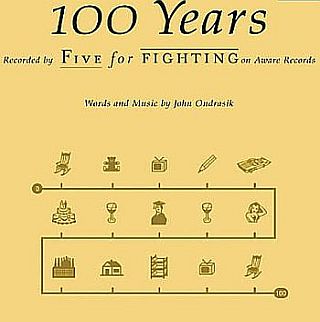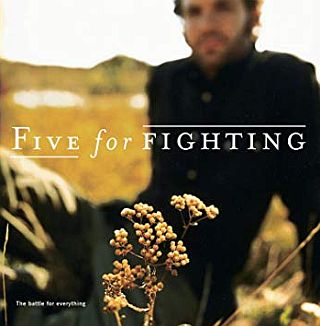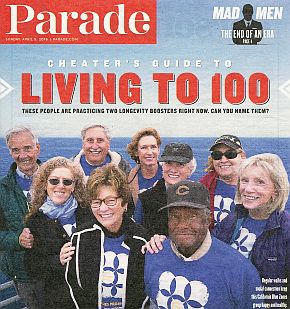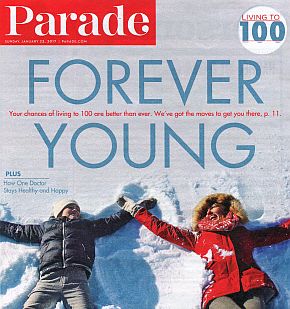The title of the song is “100 Years,” a popular tune from 2003. It was written and performed by John Ondrasik, who uses the stage name, Five for Fighting.
“100 Years” was the first single from his third studio album, The Battle for Everything. The single was released ahead of the album, in November 2003, but both would become million sellers.
Music Player
“100 Years” – Five For Fighting
(scroll down for lyrics)
“100 Years” is a song for the ages; its lyrics and composition aptly capture the wistfulness of life flying by – and the progression of life stages. And the spare but perfectly-suited instrumentation by piano, gives it a weighty poignancy and a lingering, classic appeal.
By early 2004, “100 Years” had risen to No. 28 on the Billboard pop chart. And on the Billboard Adult Contemporary chart, the song did better, hitting No. 1. In fact, on that chart it was the longest running No. 1 single of the year, doing so during May-September 2004. It claimed the top spot for 12 non-consecutive weeks. In December 2004, on Billboard’s end-of-the-year music chart, “100 Years” was also ranked No. 77 for the year.
“100 Years” also reached the top 40 in Australia and New Zealand, peaking at No. 32 in both countries. In 2007, the song surpassed more than 1 million copies sold, earning Platinum certification from the Recording Industry Association of America.
“100 Years” is not so much about reaching the age of 100, or a song in praise of seeking that milestone as a goal. Rather, this is a song lamenting time’s passing – and in a fashion, about how brief a time 100 years actually is, or more exactly, how quickly all of those years actually pass by in one person’s life. The song, depending on listener, may also summon an accounting of what one has done, not done, or might have done, with those years. For the young, it is an offering of possibilities and what might be — “time to lose yourself within a morning star,” as one lyric puts it.
During 2004-2006, “100 Years” also received exposure from its use on various TV programs and movies, among them: One Tree Hill (2004), Smallville (2004), JAG (2005), Scrubs (2006), the ABC Family movie, David Heart (2004), and also during Katie Couric’s last day on the Today Show (May 31, 2006). The song was also used as musical backing for a video montage of the 2004 Stanley Cup ice hockey playoffs broadcast after game seven of the finals on Canadian TV’s Hockey Night in Canada (John Ondrasik, by the way, is a serious ice hockey fan, and his stage name, Five for Fighting, is in fact, an appropriated ice hockey phrase meaning, five penalty minutes for fighting on the ice.)
But it was the song’s use as the backing track for a 2005 Chase credit card TV commercial (above) that also boosted the song’s exposure. That ad, titled “Life,” produced by the McGarryBowen agency of New York, ran during primetime ABC, CBS and NBC shows such as “Lost,” “Survivor,” and “Will & Grace.” Although a music video was prepared for the song, and was quite successful, the Chase TV commercial hyping its credit card services, did a pretty good job of actually capturing, visually, the essence of the song and its message.
|
“100 Years” I’m 15 for a moment I’m 22 for a moment 15 there’s still time for you I’m 33 for a moment I’m 45 for a moment 15 there’s still time for you 15 I’m all right with you Half time goes by I’m 99 for a moment 15 there’s still time for you oooooh, oooooh, oooooh, ooh 15 there’s still time for you |
The Chase ad portrays a young male traveling through his various “life stages” – college, job, marriage, family, retirement, grandkids – life stages that are also the subject of “100 Years.” And conveniently for Chase, those life stages are also junctures of commerce when one or more type of credit card Chase issues and co-brands might be useful – such as Continental Airlines, Disney, Amazon, or AARP – each of which appears briefly as the ad runs.
The Chase commercial using “100 Years” in its soundtrack was quite well done visually, hitting all the right emotional buttons. It spurred numerous queries to the web in search of the song’s title and artist. The song and its lyrics, however, are worth a closer look.
Song’s Message
The narrator begins with age 15, which he describes as a time “caught between 10 and 20″ when he is “just dreaming.” And here, as a teenager, he appears to be thinking about, and forming himself, for some unknown love in his future. As John Ondrasik has recounted of his own life at that age, it was an awkward time; a time when he had no girl friend.
By age 22, however, all that bad teen angst is history, and the narrator, now in his early twenties, is flying high, and has found his love – “we’re on fire, making our way back from Mars.”
Then comes what might be called “the counseling chorus,” which is repeated later. The narrator here seems to be advising a 15 year-old – about the time he is in and the time he has left: “time to buy and time to lose” – early years, time to wonder and experiment; time to learn; a time of trial and error — but still, a time to make these early years count. “Never a wish better than this,” than to be 15 — with a full road ahead, 85 or more to go…
Back on the narrator’s life track, meanwhile, he is now 33 – “for a moment.” But now he is “a they,” he explains, a family man — “kid on the way…family on my mind.”
At 45 he finds the sea of life is “high” around him, as the years have mounted. And at this point there could be what some call “a mid-life crisis” looming. So now, perhaps, he’s beginning to chase — or reclaim/relive — some of his former self from earlier years?
Again, back to 15 when it was all there before you, really – “never a wish better than this.” Especially when “you only got 100 years to live.”
At the half-way mark there is some reflection. Travelling this far, he appears to be saying, you finally get a little knowledge and you think you’re pretty good at life’s chores and figuring it all out… But soon, 67 is gone in a blink of an eye… And you’re moving on…
By age 99, he is looking back, but still hoping for a bit more time – “time for just another moment.” Then there is a quick recap of the years rolling by – at 15, 22, 33 and more, also reminding us that “every day is a new day”… Carpe deim! But in the end, our narrator appears to be coming full circle, back to age 15, with that counseling chorus — “there’s still time for you.”
In any case, throughout his song, Ondrasik gets it right; suggesting that the sand-in-the-hour-glass slows down for no one. The years are precious intervals and we are all privileged to have those gifts of time. And in the end, it’s not how many years you live, but rather what you have made of them – and how well you have done by the people you’ve known, the family you’ve had, and your own personal truths and measures.

An image taken from the "100 Years" video, showing song author and performer John Ondrasik, along with some lyrics.
A version of the video posted on YouTube.com has collected more than 37 million views and 11,000 comments (as of 2019), many praising the song, and some offering various takes on its lyrics and meaning. Similarly, comments on song and lyrics are also offered at SongFacts.com.

In January 1977, New West magazine featured “How To Make it To 100" as its cover story for a special year-end health issue.
Living to the age of 100 has long been thought to be something of the gold standard for those born in the 20th century – though an unreachable marker for most. However, as nutrition, medicine, and genetic knowledge advance, it appears that for those born in the 21st century, living to 100 will be a distinct possibility, and not exceptional.
A growing number of Americans are now found to be living to age 100. Nationwide, the centenarian population has grown 65.8 percent over the past three decades – from 32,194 people who were age 100 or older in 1980 to 53,364 centenarians in 2010, according to new Census Bureau data (as of January 2013). Some 82.8 percent of U.S. centenarians were female.
Japan currently has the greatest number of known centenarians of any nation with 67,824 according to their 2017 census. They also have the highest proportion of centenarians at 34.85 per 100,000 people. According to the U.K.’s Office of National Statistics, one-third of U.K. babies born in 2013 are expected to live to 100.
Of course, for decades now, “living to 100” has been quite topical in the media, receiving generous play in the popular press. Periodic magazine stories, as the one above left, have appeared featuring the lives of those who have achieved the milestone, or other stories about the best way to get there, and still others on the latest science and/or dietary secrets for reaching 100.
Parade Magazine – the Sunday supplement magazine that comes with many Sunday newspapers across America – has periodically featured stories on living to 100, such as the two samples offered below. The April 5th, 2015 issue of Parade ran its cover titled “Cheater’s Guide to Living to 100.” A group of middle-aged to elderly folks were shown on that cover with small print above saying “these people are practicing two longevity boosters now. Can you name them?” And again in January 2017, Parade headlined a “Living to 100” story with the title, “Forever Young,” noting, “Your chances of living to 100 are better than ever,” and adding: “We’ve got the moves to get you there.”
Time magazine has also periodically visited the “living-to-100” story, or variations thereof, as the three sample covers below illustrate, these respectively, from 2004, 2010, and 2015. In August 2004 Time ran a cover story with the tagline, “How to Live To Be 100 (and not regret it)” – this last point focused on the quality of life in those elder years. In a February 2010 cover story, Time featured “The Science of Living Longer,” showing three stages of a woman’s life, from young girl to older woman. Five years later, in February 2015, Time blew past the age 100 marker, featuring a baby on the cover who Time said “could live to be 142 year old”!
Time, and other of the popular media, delivering stories on this subject, usually focus on the latest information from science and long-term studies. Typically, the message is that some combination of genetics, diet, and lifestyle figure into the magic formula for long life. Some of these stories also point to places such as Okinawa, Japan; Sardinia, Spain; and Nova Scotia, Canada where clusters of long-lived individuals have been studied, hoping to find their “secret sauce.” Then there are also a slew of magazines, specialized publications, and one-time editions that offer advice, counsel, and/or various products to aide those striving to reach 100. A sampling of some of these are offered below.
 2018. "Live to 100", U.K. magazine. |
 2013. "Prospect" magazine, U.K. |
 2011. Dr. Oz, "Men's Fitness". |
One U.K. magazine, Live to 100 – “dedicated to inspiring people to lead healthier lives” – has featured a Dr. Hilary Jones on its cover periodically – “Live Longer My Way!” says one of his taglines on a recent issue. Another U.K magazine, Prospect, a monthly British essay and comment magazine, ran a special issue in 2013 on living to 100, including an article by American author and radio personality, Garrison Keillor, with the billing, “Living To 100: Now It’s Normal What Will You Do?” And Dr. Oz, a well-known celebrity physician in the U.S., is shown on a Men’s Fitness cover of July 2011 for the story, “Dr. Oz Shows You How to Live to 100 (and live well).”
In addition, a number of books have also been published on the “100 years of life” theme. Among titles released in recent years, for example, noted above, are: John Robbins’ 2007 book, Healthy at 100: The Scientifically Proven Secrets of the World’s Healthiest and Longest-Lived Peoples (384 pp., Ballantine Books); Lynda Gratton and Andrew Scott’s 2017 book, The 100-Year Life: Living and Working in an Age of Longevity (424pp., Bloomsbury Business, paperback); and Thomas T. Perls and Margery Hutter Silver’s 1999 book, Living To 100: Lessons In Living To Your Maximum Potential At Any Age (304 pp., Basic Books, paperback).
Music Best

Song author, John Ondrasik, shown on cover of 'Five for Fighting, Live' album, which also includes a version of '100 Years'. Click for CD.
However, the more poignant stories, perhaps, are those that come with music, as in John Ondrasik’s “100 Years” song. And of course, his is not the only song on the subject.
One listing at SongFacts.com, for example, includes more than 180 songs that have something to do with aging or age-related themes. And periodically, some of the more thoughtful radio stations will offer special broadcasts that group songs around one or more age-related themes.
In any case, music looking back on one’s life – the joys and the trials, the loves lost and won, the wisdom gleaned or missed, and more – will always have strong appeal. And the John Ondrasik song, “100 Years,” is definitely one worth keeping on the playlist.
Readers who liked this story may also find the following stories of interest, which also sample music with related “life story” themes and lyrics, including: “Cycles” (Frank Sinatra), “What A Wonderful World” (Louis Armstrong), “Life is Beautiful” (Vega 4), “Taxi” (Harry Chapin), and “In My Life” (The Beatles). Thanks for visiting – and if you like what you find here, please make a donation to help support the research and writing at this website. Thank you – Jack Doyle
|
Please Support Thank You |
____________________________________
Date Posted: 24 April 2019
Last Update: 25 January 2024
Comments to: jackdoyle47@gmail.com
Article Citation:
Jack Doyle, “100 Years To Live: 2003-2004,”
PopHistoryDig.com, April 24, 2019.
____________________________________
Sources, Links & Additional Information
“100 Years,” Wikipedia.org.
“Five for Fighting” (John Ondrasik), Wikipe-dia.org.
JPMorgan Chase, Press Release, “Campaign Positions Chase as Company that Empowers Consumers Throughout Life’s Important Moments,” May 9, 2005, New York, NY.
“JPMorgan Makes Its ‘Choice’,” Adweek, May 9, 2005.
“Playing the ‘Heart Strings’ Card: JPMorgan Chase’s New Ad Connects with Consumers on an Emotional Level…,” U.S. Banker, July 5, 2005.
Apple/iTunes, “Commercial Success:50 Songs That Sell,” Apple.com, October 7, 2005.
Tim Nudd, “Apple Picks 50 Top Songs from Commercials,” Ad Week, October 11 2005.
“Five for Fighting – 100 Years: Music Video,” YouTube.com, posted October 2, 2009.
“100 Years by Five For Fighting,” SongFacts .com.
“Songs About Getting Older” (list of 186 songs), SongFacts.com.
Richard Corliss and Michael D. Lemonick, “How To Live To Be 100. New Research Suggests That a Long Life Is No Accident. So What Are the Secrets of the World’s Centenarians?,” Time, August 30, 2004.
Emily Brandon, “What People Who Live to 100 Have in Common; U.S. Residents in Several States Live Considerably Longer than the Rest of the Country,” U.S. News & World Report, January 7, 2013.
Bronwen Maddox, “Editorial: Living to 100,” and Cover Story, Garrison Keillor, “Living to 100. Now it’s Normal, What Will You Do?,” Prospect (U.K. magazine), March 2013.
“How Many Singaporeans Are Living to 100 Years Old?,” Population.sg, March 2016.
“More than Half of World’s Wealthy Expect to Live to 100: Survey,” Reuters.com, April 19, 2018.
John Robbins, Healthy at 100: The Scientifically Proven Secrets of the World’s Healthiest and Longest-Lived Peoples, 2007, Ballantine Books, 384pp.
Lynda Gratton and Andrew Scott, The 100-Year Life: Living and Working in an Age of Longevity, 2017, Bloomsbury Business, paperback, 424pp.
Thomas T. Perls and Margery Hutter Silver, Living To 100: Lessons In Living To Your Maximum Potential At Any Age, 1999, Basic Books, paperback, 304pp.
_____________________________











